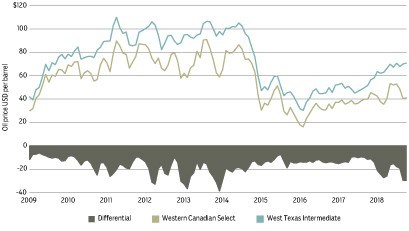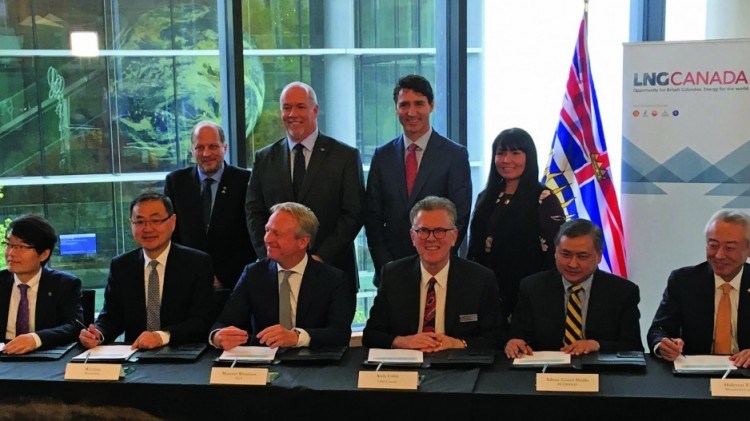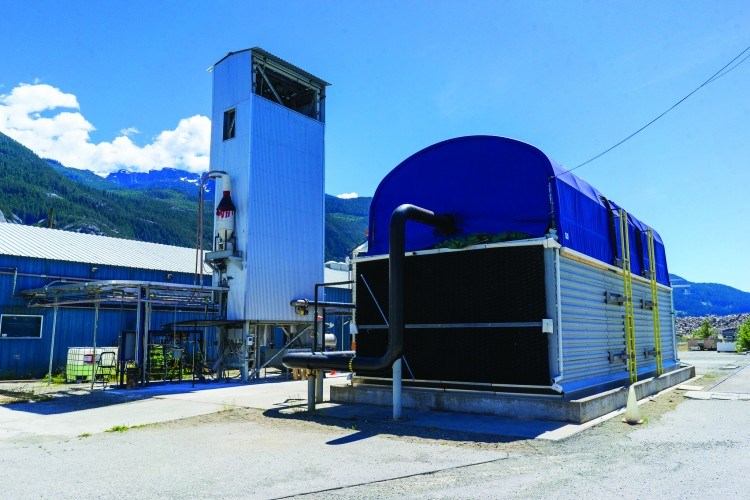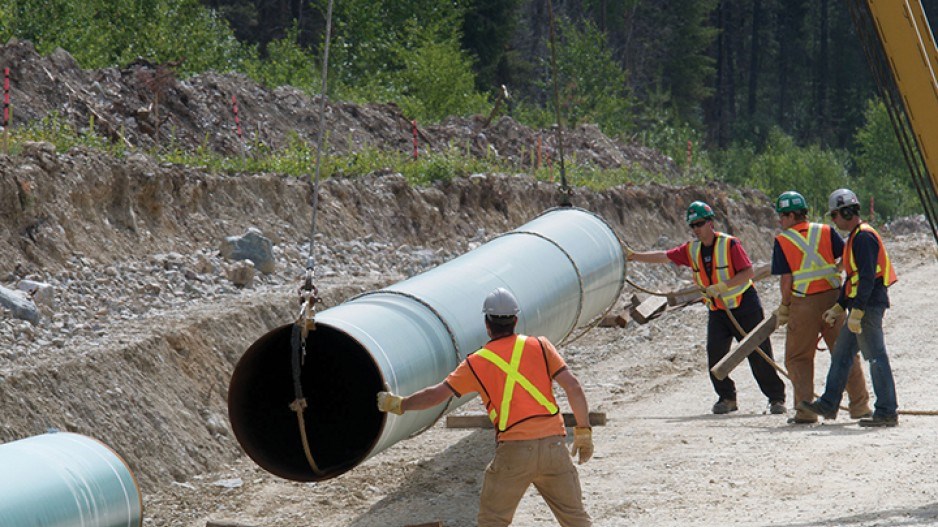For B.C. and the rest of Canada, 2018’s biggest business news stories were connected to carbon: how to get more of it to U.S. and Asian markets in the form of oil and liquefied natural gas (LNG) while releasing less of it into the atmosphere.
It was the year in which Canadians bought a pipeline and suffered through a brief B.C.-Alberta trade war over it. A $40 billion investment was also committed to an LNG project in B.C., gasoline prices in Vancouver hit record highs and desperate measures were taken in Alberta to boost oil prices.
It was also the year that Ontario’s Doug Ford government moved backwards on its climate action commitments – scrapping a cap-and-trade program – while B.C. went in the opposite direction, and the Intergovernmental Panel on Climate Change (IPCC) issued a special report calling for global carbon reduction targets that appear to be impossible to meet.
One of the biggest debates in Canada in 2018 was whether the country can develop and export fossil fuels while meeting its Paris Agreement commitments.
Canada buys a pipeline
In February, John Horgan’s BC NDP government announced plans to restrict the flow of diluted bitumen through B.C. by rail or pipeline – just one of the tools it was using to try to halt the $7.4 billion Trans Mountain pipeline expansion, which is key to getting Alberta oil to global markets.
Alberta Premier Rachel Notley responded by cancelling talks between her province and B.C. on the prospect of Alberta buying clean power from B.C. – something she said would cost B.C. $500 million in potential new revenue.
She then banned B.C. wine imports and threatened to throttle the flow of oil to B.C. Notley’s throne speech put the Horgan government on notice.
“In the past when workers in our energy industry were attacked and when the resources we own were threatened, [former Alberta premier] Peter Lougheed took bold action,” she said through her lieutenant-governor.
“We will not hesitate to invoke similar legislation if it becomes necessary owing to extreme and illegal actions on the part of the B.C. government to stop the pipeline.”
That legislation is now in place, although a temporary truce resulted when B.C. backed off somewhat and said it would ask the courts first if it had the authority to restrict the movement of oil from Alberta.
Meanwhile, in April, Kinder Morgan Canada (TSX:KML) dropped a bombshell. It gave the federal and provincial government an ultimatum: give the company assurances that the $7.4 billion expansion can proceed or it would take a $1 billion loss and cancel the project.
Despite having National Energy Board approval, the project had suffered repeated setbacks due to protests, court challenges and opposition from the B.C. government and First Nations.
In 2018, more than 200 people were arrested in Burnaby for defying court injunctions against protests of the expansion that had been underway at Kinder Morgan’s properties in Burnaby.
In early May, Vancouver earned the dubious distinction of having North America’s highest gasoline prices when they hit $1.62 per litre, prompting Horgan to muse out loud that perhaps what B.C. needed was a new refinery.
Energy experts pointed out that pipeline constraints were one of the reasons for Vancouver’s high gasoline prices because nearly half of the refined fuels used in B.C. come from Alberta refineries.
Accused of looking weak and ineffectual, the federal government made a shocking announcement at the end of May: it would buy Kinder Morgan’s existing pipeline for $4.5 billion, assume the risks and responsibilities of pushing the expansion through and then try to sell the expanded pipeline.
But the project suffered another setback. At the end of August, the Federal Court of Appeal quashed the order-in-council that had approved the expansion. It ruled that Ottawa had failed to properly consult First Nations and assess increased oil tanker traffic’s potential impacts on the marine environment.
The project is still on hold while the federal government attempts to redo the work ordered by the court.
In the midst of all this, despite criticisms that there is no demand for Alberta oil in China, at least four oil tanker shipments to Asia were booked out of Vancouver in 2018’s fourth quarter, and Statistics Canada confirmed that, between January and August, 873,473 barrels of heavy crude from Alberta were shipped to China via Vancouver.
Oilsands expand without pipelines
But pipeline expansion delays aren’t exclusive to Trans Mountain. The Keystone XL and Line 3 projects have also suffered setbacks. As a result, shipments of oil by rail in Canada hit a record in July when railways transported 206,624 barrels per day to the U.S.
But even that workaround faces constraints. New regulatory changes aimed at addressing public safety and environmental hazards associated with oil by rail went into effect in 2018 in the U.S. and Canada. That increased the challenge of moving Canadian oil to American markets. In 2018, oil was even transported by truck.
“Globally, it has been a record year,” said Tim McMillan, president of the Canadian Association of Petroleum Producers (CAPP). “Global demand for both oil and gas is increasing at a record amount, global investment is bouncing back substantially, and Canada is not part of it.”
Increased oilsands production has exacerbated already severe pipeline constraints.
In early 2018, the new $17 billion Fort Hills oilsands project began producing oil.
Vancouver’s Teck Resources (TSX:TECK.B; NYSE:TECK) owns 21% of the project. In 2018, Teck continued to bet on Alberta’s oilsands by announcing that the joint environmental review had begun on its new $20 billion Frontier oilsands project.
Critics pointed to the folly of expanding oil production in Alberta in advance of getting new pipelines built, and in 2018’s second half, the per-barrel discount on Western Canadian Select crude oil compared with West Texas Intermediate widened from the traditional $15 to $40 as a result of pipeline and rail constraints.
CAPP estimated the resulting revenue loss for Alberta producers at $13 billion in 2018’s first 10 months.

In November and December, the Notley government announced two emergency measures, including oil production cuts aimed at lifting the price of Alberta oil. Starting in January 2019, Alberta will implement an 8.7% oil production reduction.
Notley also said her government would spend $350 million on new railcars to move 120,000 barrels of oil per day – a stopgap measure intended to address the pipeline capacity crunch.
Multibillion-dollar credibility lifeline
By the fall of 2018, the Trudeau government, hammered by business groups for creating a climate they said was over-regulated and hostile to foreign investment, was facing a confidence crisis.
In April, more than 75 chambers of commerce, mayors and business groups signed a petition calling on Prime Minister Justin Trudeau to assert Canada’s authority and get the Trans Mountain pipeline expansion on track.
Business groups also railed against the Trudeau government’s new Bill C-69 environmental assessment plan. They argued that it would exacerbate Canada’s reputation for being overburdened with regulation.
Their obstructionist reputations reaching a peak, Trudeau and Horgan were thrown a multi-billion-dollar lifeline in October when Royal Dutch Shell and its partners approved the $40 billion LNG Canada project.
The project, which includes a $14 billion liquefied natural gas plant in Kitimat, a $6.2 billion natural gas pipeline and billions more in upstream development, will generate an estimated $22 billion in tax and royalty revenue for the B.C. government over the life of the project.
It will also provide roughly 10,000 construction jobs at peak construction.
At October’s formal signing agreement in Vancouver, Trudeau said LNG Canada represented the single largest private-sector investment in Canada’s history.
Business groups lauded the project as a much-needed signal to investors that Canada could deliver large energy infrastructure projects. But environmental groups ramped up opposition.
While LNG Canada enjoys unanimous support from elected First Nations councils in Kitimat and along the pipeline corridor, the Canadian Centre for Policy Alternatives has described the project as a “carbon bomb.”
Environmental groups like the Pembina Institute and BC Green Party Leader Andrew Weaver have said LNG Canada will make it all but impossible for B.C. to meet its climate change policy goals, which include a 40% reduction in greenhouse gas emissions by 2030.
Weaver even threatened to bring down the government over the NDP government’s support for LNG. He appeared to back off of that threat, however, with the release of B.C.’s CleanBC climate and energy plan.

Canada’s carbon tradeoffs
The Trudeau government’s support for projects like the Trans Mountain pipeline expansion and LNG Canada was not a blank cheque. The prime minister made it clear that, in order to continue to develop Canada’s oil and gas industries, it needed commitments on climate change policies.
Trudeau had found an ally in Notley, whose government passed what is arguably Canada’s most ambitious provincial climate change plan. It caps oilsands emissions and commits to phasing out coal power by 2030. The plan also introduced a carbon tax and committed the government to investing in wind power and reducing methane emissions by 45%.
Nationally, Trudeau’s Pan-Canadian Framework on Clean Growth and Climate Change included a carbon tax backstop that would be forced upon provinces that refused to introduce their own carbon tax or cap and trade.
But by 2018, there were feelings of betrayal, on the part of both Alberta and environmental groups.
Notley complained that Alberta had lived up to its end of the bargain by introducing stringent new climate change policies, only to find pipeline projects blocked. The province’s climate change policies are now threatened by anti-pipeline politics.
In mid-December, the Alberta premier announced that her government would delay its oilsands emissions cap until after the spring 2019 election. That followed Notley’s announcement in August that Alberta would suspend plans to harmonize Alberta’s carbon tax increases with Ottawa’s until the Trans Mountain expansion issue was dealt with.
“It is clear that opposition to all efforts to expand pipeline capacity has set back the progressive policies the Alberta government introduced to reduce emissions, including carbon taxes, phase-out of coal-fired electricity generation and a cap on oilsands emissions,” said Marvin Shaffer, adjunct professor at Simon Fraser University’s School of Public Policy.
“Just like B.C., Alberta was trying to balance industrial policy with commitments to reduce GHG [greenhouse gas] emissions, but we are already seeing how opposition to the former will undermine commitment to the latter.”
Environmental groups also claimed they were betrayed by Trudeau trying to paint his government as a climate change leader while supporting the fossil fuel industry.
A Stand.earth report released at December’s COP24 conference in Poland warned that Canada’s continued support for fossil fuels meant it would need to double its GHG reductions to 60% below 2005 levels by 2030 rather than the current target of 30%, if it is to meet its targets.
That target seems far-fetched, given the opposition to the federal government’s climate change plans by some provinces.
In 2018, Saskatchewan declared war on Ottawa’s national carbon-pricing scheme by launching a constitutional challenge of the federal government’s attempts to force carbon pricing on the province.
Ontario and Manitoba have joined in the fight. In 2018, they abandoned their respective carbon-pricing schemes, objecting to what they claimed was strong-arming on the part of Ottawa.
B.C. moved in a different direction, however.
Its ambitious CleanBC climate change and energy strategy announced in December relies heavily on electrification to remove 8.4 million tonnes of carbon dioxide from the industrial sector by 2030.
The plan also increases the percentage of renewable fuel in gasoline, mandates a 15% renewable content for natural gas and includes a zero-emission vehicle mandate.
Shaffer said the plan’s effectiveness will depend on how extensive the electrification is and how much it will cost British Columbians.
“The government won’t want to increase pressure on BC Hydro and [its] rates by absorbing those costs. Industry won’t be able to pay for them and remain globally competitive. And government will not want to crowd out other important social and infrastructure spending with large electrification subsidies.
“There is a long history of governments announcing bold GHG reduction targets but abandoning them as it becomes apparent what they require. It remains to be seen whether this climate plan will meet the same fate.
“This isn’t to say that B.C. won’t make considerable progress in reducing carbon emissions in the province. There are many elements of the plan that will go forward and have significant effect. But whether B.C. will and should achieve the specific numbers and dates in the plan, as currently set out, is very much in doubt.”
The IPCC’s Mission Impossible
Keeping global warming to within 1.5 C would require cutting the world’s carbon emissions by 45% in just 12 years, according to an IPCC report released in October.
And if that were to be accomplished using carbon pricing as the principal tool, it would require per-tonne prices of US$135 to US$5,500, according to IPCC calculations.
But given the International Energy Agency’s (IEA) most recent energy outlook, what the IPCC report really suggests is that few industrialized countries that signed the Paris Agreement are likely to meet their 2030 targets.
Canada’s climate change targets call for a 30% reduction in GHG emissions below 2005 levels by 2030; B.C.’s plan calls for a 40% reduction.
Despite some promising projections about the increase in renewables and electric vehicles, the IEA’s World Energy Outlook 2018 suggests global energy demand is out of step with the IPCC’s targets, because oil and gas demand will continue well past 2030.
Projections in the IEA report include:
•the use of oil for cars will peak in the mid-2020s, but demand from petrochemicals, planes, trucks and ships means oil consumption will continue on “a rising trend”;
•rising incomes and population growth will increase global energy demand by more than 25% by 2040;
•natural gas will overtake coal in 2030 to become the second-largest fuel source in the global energy mix;
•LNG trade will more than double, with demand led by China; and
•power generation from renewables will rise from 25% today to around 40% in 2040.
Negative carbon captures the imagination
While B.C. has been a recent battleground over carbon--intensive projects like the Trans Mountain pipeline and LNG projects, it has also provided fertile ground for clean-tech companies that have lately received national attention for technologies that address climate change.
For example, Calgary’s Carbon Engineering demonstration project in Squamish was featured in Vice, Forbes, the Guardian, The Economist, the New York Times, National Geographic and The Atlantic and by the BBC in 2018.
Steve Oldham, the company’s CEO, thinks all the recent attention is because, while other technology solutions are geared toward low or zero emissions, Carbon Engineering’s process can achieve negative emissions, if used for carbon capture and storage. At the very least, if used to make fuel, it would be carbon-neutral.
“Every climate report that has come out this year has stated that negative emissions are now essential,” Oldham said.
“As a result of that, people are looking for solutions because that’s a hard problem. We’ve had over 700 different companies worldwide contact us and ask about partnering with us to bring that technology into the market.”
The company, whose largest private investor is Microsoft Corp. (Nasdaq:MSFT) founder Bill Gates, uses direct-air capture to remove carbon dioxide from the atmosphere. Its Squamish project was started in 2014.

The challenge for direct-air carbon capture has been the high energy inputs required. At US$600 per tonne of CO2, most direct-air carbon capture doesn’t make economic sense. But in 2018, Carbon Engineering published research in the energy journal Joule that claimed a breakthrough on costs.
The paper claims it has demonstrated that direct air capture can be done for US$94 to US$232 per tonne.
While its technology can be used to capture and sequester carbon, Carbon Engineering has also developed an air-to-fuel technology, in which hydrogen is combined with the captured carbon to make a drop-in fuel that can be used in sectors like aviation, which, unlike cars, can’t simply switch to electric power. Currently, the fuel would cost about 25% more than conventional jet fuel.
“As we build out, our costs will come down,” Oldham said. “Meanwhile ... governments have incentives, tax credits, penalties, regulations that relate to carbon content in fuel, and those regulations create a market that allows us to recover that 25%.”
In 2018, Carbon Engineering closed an $11 million capital funding deal, and in 2019 it plans a second-phase expansion of its demonstration plant in Squamish. The expansion will increase the amount of carbon capture from the current one tonne per day to 10 tonnes per day.
Oldham added that early in the new year, he expects several announcements on partnerships to develop commercial-scale plants.
Other B.C. clean-tech companies making headlines in 2018 included:
•Ballard Power Systems (TSX, Nasdaq:BLDP), which gained a major new partner in China, when Weichai Power took a $163 million stake in the company;
•Richmond’s Corvus Energy, which announced in November it would invest $12 million in a new battery plant in Norway and automate its Richmond plant;
•Electra Meccanica Vehicles Corp. (Nasdaq:SOLO), which designed a single-person electric car, went public on the Nasdaq and marked its first production in a manufacturing plant in China; and
•Burnaby’s General Fusion, which landed $49 million in federal funding for its fusion power research. =




